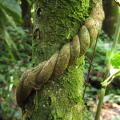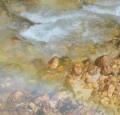
DMT-Nexus member
Posts: 1111 Joined: 18-Feb-2017 Last visit: 12-Jul-2024
|
If you leave Ayahuasca to stand for some time, the plant gunk will settle and it will become thicker at the bottom of the bottle and more watery at the top.
I understand why that happens - the gunk is heavier so it falls.
However, what I don't understand is why the heavier stuff is also richer in alkaloids. A tiny bit of the sediment can be as strong as a shot glass of the soup from the top of the bottle.
If the alkaloids were freebase, they would fall with the other sediments. But they are in salt form, so they're dissolved in the water. And by definition, the solute should be distributed uniformly throughout the solvent. (Wikipedia says "a solution is a homogeneous mixture" ).
I realize the soup in its entirety is not a solution, but rather a colloid (possibly emulsified). However, the water and alkaloids fraction of it is a solution. It seems the heavier stuff attracts more alkaloids?
|
|
|
|
|

DMT-Nexus member

Posts: 3090 Joined: 09-Jul-2016 Last visit: 03-Feb-2024
|
Wow, that's a good question. Maybe the effects of gunk in a solution can be compared with how dust particles in the sky can cause it to rain.
It could also be that gunk is more potent, not because it has a higher concentration of alkaloïds, but because it is absorbed in the bloodstream faster.
If gunk in the stomach behaves simmilarly to how it behaves in a jar, then it would sink to the bottom and pass the gastrointestinal tract quicker, than if it would just keep floating around.
|
|
|

DMT-Nexus member
 
Posts: 3968 Joined: 21-Jul-2012 Last visit: 15-Feb-2024
|
Could it be that a significant quantity remains locked in the plant cells? That seems the most likely answer to me. Sine experientia nihil sufficienter sciri potest -Roger Bacon
*γνῶθι σεαυτόν*
|
|
|

DMT-Nexus member
Posts: 377 Joined: 19-Aug-2017 Last visit: 15-Jan-2021
|
While the sediment may contain some plant tissue bits, it is largely precipitated tannin [tannic acid]. Tannic acid makes a poorly soluble salt with DMT and also with harmine/harmaline [I experimentally verified the latter in a test tube]. So when the brew cools and the tannin precipitates, DMT tannate and harmine tannate also precipitate and eventually settle to the bottom. That is why the dregs are kick-ass strong. I once made a very strong brew that was just milky thick with tannin and had the 'bright idea' to heat it up and redissolve the sediments immediately before consumption. The amount of vomiting bordered on legendary. Tannin is what is used to tan leather  Just mix the brew well as you portion it out and serve up the groups hardhead last 
|
|
|

DMT-Nexus member

Posts: 3090 Joined: 09-Jul-2016 Last visit: 03-Feb-2024
|
Elrik wrote:While the sediment may contain some plant tissue bits, it is largely precipitated tannin [tannic acid]. Tannic acid makes a poorly soluble salt with DMT and also with harmine/harmaline [I experimentally verified the latter in a test tube]. So when the brew cools and the tannin precipitates, DMT tannate and harmine tannate also precipitate and eventually settle to the bottom. That is why the dregs are kick-ass strong. I once made a very strong brew that was just milky thick with tannin and had the 'bright idea' to heat it up and redissolve the sediments immediately before consumption. The amount of vomiting bordered on legendary. Tannin is what is used to tan leather  Just mix the brew well as you portion it out and serve up the groups hardhead last  Hey, could this also help to explain the experiential difference in effects between chacruna and chaliponga? There's a whole thread here on whether or not chaliponga contains trace amounts of 5-MeO-DMT...it turned out there is no 5-Meo in chaliponga, though many people (myself included) are convinced that the difference in effects could not be explained by the placebo-effect.
|
|
|
DMT-Nexus member
Posts: 1114 Joined: 13-Jul-2014 Last visit: 06-Feb-2024
|
dragonrider wrote:Hey, could this also help to explain the experiential difference in effects between chacruna and chaliponga? There's a whole thread here on whether or not chaliponga contains trace amounts of 5-MeO-DMT...it turned out there is no 5-Meo in chaliponga, though many people (myself included) are convinced that the difference in effects could not be explained by the placebo-effect. I wonder if it's just some background compounds in the Chaliponga that gives it a perceived difference, you'd be surprised at just how much different compounds or plants can synergize with or alter in some way, the DMT/Aya experience.
|
|
|

DMT-Nexus member
Posts: 1111 Joined: 18-Feb-2017 Last visit: 12-Jul-2024
|
Thanks guys. I'm convinced by Elrik's tannic acid theory. dragonrider wrote:Hey, could this also help to explain the experiential difference in effects between chacruna and chaliponga?
There must be something in Chaliponga that affects the experience. It's not just the mental effects, even the effect curve is different - it comes in waves, sometimes hours in when you think it's over.
|
|
|

DMT-Nexus member

Posts: 3090 Joined: 09-Jul-2016 Last visit: 03-Feb-2024
|
Jagube wrote:Thanks guys. I'm convinced by Elrik's tannic acid theory. dragonrider wrote:Hey, could this also help to explain the experiential difference in effects between chacruna and chaliponga?
There must be something in Chaliponga that affects the experience. It's not just the mental effects, even the effect curve is different - it comes in waves, sometimes hours in when you think it's over. Indeed...but could it be that DMT as a tannic salt is responsible for this? Some people claim that DMT fumarate has slightly different effects than DMT hydrochloride. And chaliponga definately has more tannins in it than chacruna.
|
|
|

DMT-Nexus member
Posts: 1111 Joined: 18-Feb-2017 Last visit: 12-Jul-2024
|
dragonrider wrote:Indeed...but could it be that DMT as a tannic salt is responsible for this? Some people claim that DMT fumarate has slightly different effects than DMT hydrochloride. And chaliponga definately has more tannins in it than chacruna. I see, and don't know the answer, but it sounds plausible. The effects are distinct and when I was blind-given it in ceremony I recognized it; it feels similar at first, but later on (especially at larger doses) it changes. If I were to venture a guess based on experience only, I'd say it's some kind of tryptamine, different from DMT as I know it from Chacruna. But IIRC the tests showed DMT as the only alkaloid. So it may be DMT in a different form, and bound by some other molecules which slow down its onset. Whatever it is, it is IME more challenging by at least an order of magnitude. BTW the closest other thing I've experienced similar effects from was Yopo seeds. But that was just one experience years ago, not enough data to draw conclusions from.
|
|
|

DMT-Nexus member
Posts: 562 Joined: 20-Nov-2009 Last visit: 07-Jan-2023
|
Good post Jagube. When I have in dreams boiled 25 grams of blended up hawaiian psychotria in 1 and 1/4 bottle of spring water for 1/2 hour, then filter thru a coffee filter made of fine wires, then filtred thru a cotton ball stuffed into a large clean automotive funnel, then reduced down to 3oz, the brew will of course be filtered well and a dark tea colored hot liquid that should be used right away -- as I always found it in dreams to be non-gunk looking and very potent. p.s With so much good hawaiian psychotria floating around, never saw the need to mess with chaliponga, as my few experiences with it were all over the place,--as it can turn on you in an instance and it's very long lasting so if you get into a challenging experience, it can last a while, I found chacruna to be very forgiving, nice, very potent, streamligned with no physical or emotional weirdness, just pure bliss with chacruna. Chaliponga is definately only for very experienced advanced users like Shamans, etc. I will never go near it again, and if you do ever use want to keep the dose very low like less than 3 to 5 grams max. I ventured beyond that and it was not pleasant at all. The UDV, Santo Daime, Shuar Indian, and all of Benny Shanon's 150+ experiences all only use chacruna as admixture, same here. Now, if you then take that liquid and stick it in the fridge, a wide stringy & floaty looking gunk falls out to the bottom (and it does seem to diminish the strength of the experience, so I had found to never get rid of it, ie don't decant it out), but if you then re-heat that liquid again, the gunk will redissolve into the liquid to be a clear dark looking liquid once again, but the taste is even worse when re-heated back for some reason, more chalky, no explanation for this, but always prefered it fresh and hot after the 1/2 hour of boiling and quick filtering steps, then a quick reduction of the remaining hot liquid down to 2 to 3oz near shot-like. I think the alkaloids are still evenly distributed 100% throughout the entire liquid and not just in the gunk if left to fall out in the fridge, as I feel the gunk is simply plant matter that will not come out no matter what the amount of cotton ball filtering, but the filtering does get out any heavy sediment that is irritating to the intestines and causes early purging if not eliminated in my past experiments, so stomach nausea and intestinal nausea can be reduced down to zero with these 2 easy filtering steps, but the bad taste of the brew will never go away, but the taste is still way better if used fresh and hot after the initial filtering & reduction, instead of putting back in a fridge which when reheated say days later then seems to take on an additional "chalky" taste which is extra off-putting to the taste buds in my past experience, anyhow thats my 2 cents. The taste shock to the taste buds alone just from the leaf portion is off-putting to most people and some will never even give Aya a chance thanks to the terrible taste, but it's not that bad if brewed hot and fresh, still filtered hot, then reduced down to 2 or 3 oz, and dreamed immediately after adding caapi to it. For some reason, just putting it back in a fridge to sit for days after this and then re-heating later makes the taste even worst upon reconstitution of the leaf brew. The brew is already sour and bitter, has a taste like forest rot combined with tangy sourness, and that's just the leaf portion. If you read experiment 3 from Ott in the pharmahuasca section under thread "chart from the literature", you will see one of his first Aya brews was very bad tasting and they all took a taste of ginger to help kill the taste after it. He then describes the exceptional dream experience. The Shaman had first added alot of weak local leaf, but Ott had already planned for just such an occasion, and asked the Shaman if he could add his own potent leaf to the brew for everyone [and the Shaman said "but of course!"], 50 leaf per person dose, which gave the desired effect he was looking for. If you can get past the taste, you're in for a treat, as the beauty that Ayahuasca shows you is infinite in it's power, breathtaking is the word. You may remember me as 69Ron. I was suspended years ago for selling bunk products under false pretenses. I try to sneak back from time to time under different names, but unfortunately, the moderators of the DMT-Nexus are infinitely smarter than I am.
If you see me at the waterpark, please say hello. I'll be the delusional 50 something in the American flag Speedo, oiling up his monster guns while responding to imaginary requests for selfies from invisible teenage girls.
|
|
|

DMT-Nexus member

Posts: 3090 Joined: 09-Jul-2016 Last visit: 03-Feb-2024
|
Jagube wrote:dragonrider wrote:Indeed...but could it be that DMT as a tannic salt is responsible for this? Some people claim that DMT fumarate has slightly different effects than DMT hydrochloride. And chaliponga definately has more tannins in it than chacruna. I see, and don't know the answer, but it sounds plausible. The effects are distinct and when I was blind-given it in ceremony I recognized it; it feels similar at first, but later on (especially at larger doses) it changes. If I were to venture a guess based on experience only, I'd say it's some kind of tryptamine, different from DMT as I know it from Chacruna. But IIRC the tests showed DMT as the only alkaloid. So it may be DMT in a different form, and bound by some other molecules which slow down its onset. Whatever it is, it is IME more challenging by at least an order of magnitude. BTW the closest other thing I've experienced similar effects from was Yopo seeds. But that was just one experience years ago, not enough data to draw conclusions from. I also find chaliponga more challenging. The difference in experienced effects is definately not imagined. But i had a chacruna brew once, with lots of gunk, and it sort of aproached the chaliponga experience quite a bit. It also came in waves, a bit more than it normally does. And when it came on, there was that 'i'm being launched' kind of feeling. It didn't feel as 'alien' as chaliponga brews tend to, but it was definately more alien than what chacruna normally feels like.
|
|
|

Boundary condition

Posts: 8617 Joined: 30-Aug-2008 Last visit: 29-Nov-2025 Location: square root of minus one
|
It's worth considering that tannins (almost as broad-reaching a term as alkaloids, incidentally) themselves have significant metabolic effects. For instance, condensed ellagitannins in pomegranate are potent inhibitors of carbonic anhydrase and thereby increase the potency and duration of amphetamine at the very least and possibly other phenethylamine derivatives as well. Some tannins also inhibit various of the cytochrome P450 metabolic enzymes and some may induce the activity of yet other enzyme types. Metabolism of ayahuasca components is most certainly not confined to the monoamine oxidase system. Adsorption/absorption of tryptamine alkaloids by precipitated tannin/protein (e.g., enzyme) complexes will certainly lead to some pretty wacky pharmacodynamics, also depending on the typical charge balance of the protein concerned. (This is an on-the-fly, off-the-wall, top-of-the-head, mind splurge digest for the sake of brevity. Anyhow, very interesting question, it turns out! Really understanding where each admixture component "is at" is the very nub of the material side of the brewing aspect of ayahuasquero practice. I mean, the way this may affect/effect the metabolic fate of DMT alone is fascinating to contemplate.) “There is a way of manipulating matter and energy so as to produce what modern scientists call 'a field of force'. The field acts on the observer and puts him in a privileged position vis-à-vis the universe. From this position he has access to the realities which are ordinarily hidden from us by time and space, matter and energy. This is what we call the Great Work." ― Jacques Bergier, quoting Fulcanelli
|
|
|

DMT-Nexus member
Posts: 1111 Joined: 18-Feb-2017 Last visit: 12-Jul-2024
|
Probably some insight into the Chaliponga tannin hypothesis could be had by separating the tryptamines from the tannins (could be as simple as egg-white filtration?).
One could then bioassay the tryptamine-containing fraction and see if it still retains Chaliponga's uniqueness.
If it doesn't, it must be the tannins responsible for it.
If it does, it must be some 'wacky' tryptamine in it or DMT tannate. To find which of the two is the case, one could then convert the tannates to some other salt and bioassay that.
|
|
|
DMT-Nexus member
Posts: 1114 Joined: 13-Jul-2014 Last visit: 06-Feb-2024
|
Remember folks, background compounds in a plant can influence how the plant feels and it's flavor (not taste, flavor as in the quality/nature/feel of the experience)/effects/characteristics. Idk what all is in Chaliponga, but even trace compounds can be enough, perhaps, to alter things a bit. Ime, altering the nature of the oral DMT experience can be pretty easy, many different admixture plants can completely change the overall nature/feel of the experience and create a unique flavor of the experience, so as other plants synergize and create a unique feel, so too do background compounds within the plant, obviously. So i'd imagine that's what's going on with Chali, rather than something like tannins influencing the feel of the experience or 5-MEO.
As for tannins possibly influencing the experience, i've worked with both Mimosa and Acacia which are rich in tannins, i haven't noticed tannins playing much of a role except making the nausea/vomiting worse and if i try to clean up the tea too much the Mimosa or Acacia is reduced in potency but then again i don't use an acid when making my teas. Mimosa and Acacia do have their uniqueness and differences though, i like them both, but i think i may like Acacia better, so far, but those differences and unique flavors of the experience is brought on by the other compounds in the plant, and admixture plants on top of that can flavor it even more.
|
|
|

Boundary condition

Posts: 8617 Joined: 30-Aug-2008 Last visit: 29-Nov-2025 Location: square root of minus one
|
It might be useful to clarify the distinction between tannins and tannates/tannic acid here. Tann ins are a diverse group of phenolic compounds of which tann ates are but a smaller subset. Tannins (at least in the German sense, translated as "Gerbstoff" ) also include things such as rosmarinic acid which has established effects on mental function as well as the aforementioned ellagitannins with their proven metabolic effects. So, many of these "background compounds" may well fall into the category of tannins as a broad class of phenolics, especially if we accept that this includes hydroxylated flavonoids and their ilk. But plant biochemistry is astonishingly diverse so I'll attempt to end the tannin fixation here  It would be most instructive to see a comparative phytochemical analysis of Chaliponga and Chacruna to help fathom out this intriguing difference in subjective effects. (The difference between Acacia and Mimosa would be subject to the argument that the presence of significant quantities of NMT in the Acacia are responsible for the major subjective differences between the two but this is straying somewhat off-topic now.) “There is a way of manipulating matter and energy so as to produce what modern scientists call 'a field of force'. The field acts on the observer and puts him in a privileged position vis-à-vis the universe. From this position he has access to the realities which are ordinarily hidden from us by time and space, matter and energy. This is what we call the Great Work." ― Jacques Bergier, quoting Fulcanelli
|
|
|

DMT-Nexus member
Posts: 1111 Joined: 18-Feb-2017 Last visit: 12-Jul-2024
|
Another data point...
I reduced amiruca tea (narrow leaf P. viridis, also known as Shipibo) and as expected, was left with a layer of dregs at the bottom.
I collected them and put them in a pan with water and a bit of vinegar added. Brought that to a boil and kept it simmering for 5 minutes, then decanted off the liquid to combine with the main brew.
Out of curiosity I decided to try the 'spent' dregs, which I normally would have discarded.
A teaspoon of dregs (sorry, no exact measurement), a somewhat random amount I was hoping wouldn't be too much (without solid reasoning behind it), along with 190 mg harmine and 150 mg THH sent me on the strongest journey I'd had in two years or so. And it wouldn't let up for hours.
So clearly the 5 minute simmer with just enough water to cover it and a splash of vinegar didn't free up all (or even much) of the goodies. Maybe more washes were needed, or more vinegar, or both.
It's my understanding the DMT in the dregs is trapped as the tannate salt. Wouldn't the acetic acid have displaced the tannate ion (pKa 3.75 vs ~6)? Is a stronger acid needed, like phosphoric? Or would adding more vinegar have taken care of it?
|
|
|

DMT-Nexus member

Posts: 856 Joined: 15-Nov-2009 Last visit: 03-Feb-2025
|
Thanks for sharing, Jagube. The bottom has always been stronger in my experience also, even with plants that do not have measurable amounts of tannins. would be interested to hear about the result of any character change in chaliponga after an egg white thinning experiment. The consciousness of plants is a constant source of information for medicine, alimentation, and art, and an example of the intelligence and creative imagination of nature. Much of my education I owe to the intelligence of these great teachers. Thus I consider myself to be the “representative” of plants, and for this reason I assert that if they cut down the trees and burn what’s left of the rainforests, it is the same as burning a whole library of books without ever having read them.
~ Pablo Amaringo
|
|
|

DMT-Nexus member

Posts: 3090 Joined: 09-Jul-2016 Last visit: 03-Feb-2024
|
Another possibility could be that alkaloids could precipitate partly, forming nano particles.
It could be all kind of things causing this, like other nano particles they could precipitate on, forming larger nano particles.
Or maybe the nano particles already present just have a high percentage of alkaloids.
Given how murky aya brews tend to be, they must be packed with nano particles.
In a brew, over time nano particles will probably become more concentrated at the bottom of the brew. You will never have 100% of them dropping to the bottom though. Just like in milk and coffee.
|
|
|

In the gap between thoughts nonconceptual wisdom shines continuously.
Posts: 207 Joined: 16-Sep-2017 Last visit: 11-Mar-2024 Location: ⚗ alembic ⚗
|
Jagube wrote: Quote:Out of curiosity I decided to try the 'spent' dregs, which I normally would have discarded.
A teaspoon of dregs (sorry, no exact measurement), a somewhat random amount I was hoping wouldn't be too much (without solid reasoning behind it), along with 190 mg harmine and 150 mg THH sent me on the strongest journey I'd had in two years or so. And it wouldn't let up for hours. I have found on the forums in a few occasions a discussion about the dregs (sediment) - that when brewing the initial acidic tea with MHRB for further extraction it is very reasonable to collect the dregs (sediment) and run a separate small extraction on them to recover even more of the alkaloids.
|
|
|

DMT-Nexus member
Posts: 180 Joined: 16-Aug-2015 Last visit: 16-Nov-2025
|
The topic of sediment is indeed an interesting one -
Putting this to the test, it was observed from collecting sediment after many filtrations and 1 x refrigeration 'drop out' which has become a standard practice for my acacia brews to avoid particulates in the non-polar layer and thus easier agitation.
After collecting all the sediment together and running a simple mini A/B on this sediment, levels of alkaloid per weight turned out to be the same as the yield from the original plant matter used for the extraction itself. However, the results were extremely 'runny' as opposed to just the normal 'tacky' or 'gooey' acacia tar and could be seen to move when the plate was tilted. What the implications are regarding whether this was indeed DMT citrate or some form of tannate, I am not sure - but it was noted to be not quite as strong as the results from the original extraction itself when both were mixed 1:1 with Caapi leaf to make Changa.
|